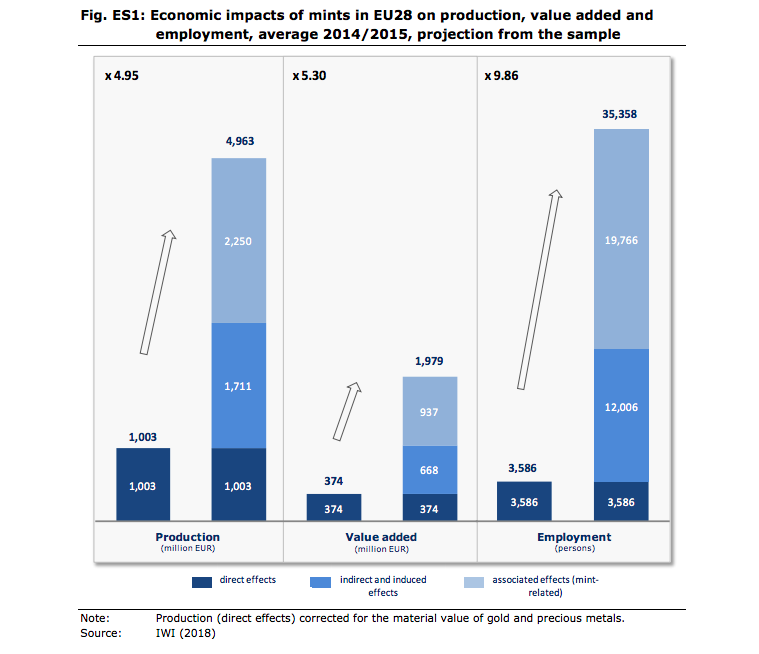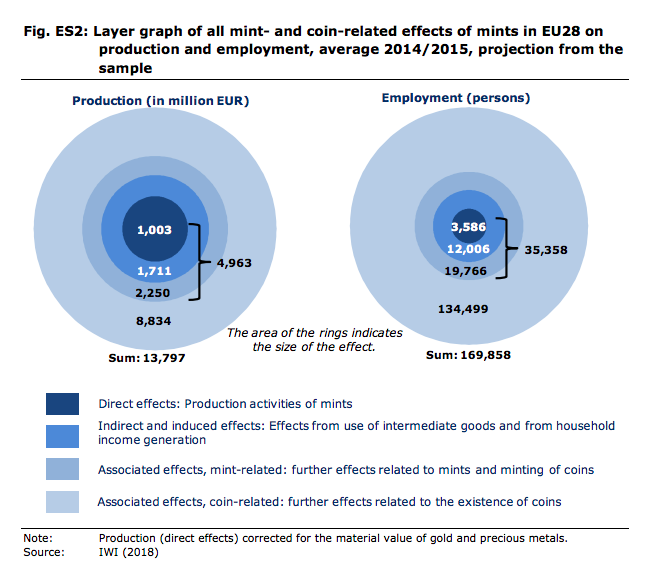
Mints in Europe EU28 from an Economist’s View (Institute for Industrial Research, 2019)
The study from the Institute for Industrial Research (iwi) presents a detailed study on the effects of coin minting on the economy and employment in the European Union. A key takeaway from the report is that the existence of coins is in the interest of nations and individuals.
Dr. Herwig Schneider and his team offer a significant contribution to the discussion about cash by putting figures on the importance and positive impact of cash on the economy and employment throughout Europe.
For the first time, these effects have now been studied for the Mints of the European Union.
Key findings include
- For every Euro coin produced by a Mint in Europe, the supply industry produces additional goods worth €4.95, with the added value for the economy amounting to €5.30 for every Euro minted.
- For each one of the 3,586 people employed at Mints, there are another 10 in the whole economy that have a job only because of the production of coins.
- Coin minting in the European Union generates more than €13 billion of production, when you add crossover, spillover and support effects.
- The employment of 16,858 people is directly or indirectly linked to coin production.
- Summing up all mint-and coin related effects, we can conclude that a total of €13,797 million of production and employment for 169,858 persons in the EU28 are generated by the macroeconomic and associated effects of mints of by the effects associated with the existence of coins in the economy.
The report gives a more complete picture of the role of coins in the European economy, using a model to quantify the economic impacts beyond the input-output model. To do this, the report delves into four dimensions: direct, indirect, induced and associated effects.

Snippet from wiiw report (July, 2019)
The study of these direct, indirect and induced effects is one of the basic tools in economics. Due to the specific nature of coins, their strategic importance and their role of directly providing cash to the public, a fourth financial dimension applies specifically to the coin business. The Institute for Industrial Research covers crossover, spillover and support effects in this fourth financial dimension:
- Small purchases effect: Many economic transactions hinge on the existence of coins, including small tips, machine purchases, donations etc.
- National budget financing effect: Since the production costs of coins are lower than their nominal value, every Mint creates added value which enters the national budget as seigniorage. The projects a state finances with the help of these funds in turn have further positive effects on the economy.
- Crossover and spillover effects in tourism: Every coin is a sort of miniature poster advertising a country, a region, an achievement in culture, sports or science, thus promoting tourism.
- Crossover and spillover effects in culture and creative industries: Coins possess a high recognition value and are therefore often taken up in cultural and creative processes.

Snippet from wiiw report (July, 2019)
